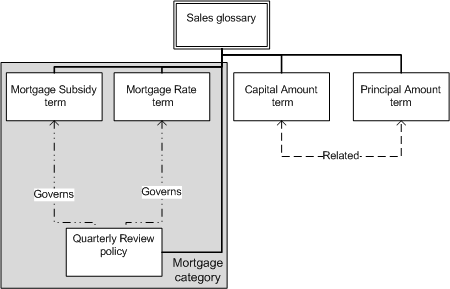Glossary Structure
Business terms, categories, policies, and glossaries are assets that constitute the structure of Business Glossary. Create Glossary assets to define and describe business concepts that are important to your organization. You can establish relationships between Glossary assets.
In addition to business terms, categories, and policies you can create business initiatives. A business initiative is a type of asset that contains business terms, categories, and policies which are impacted by a business decision or business change. The data steward can publish the business initiative to publish all the business terms, categories, and policies that are part of the initiative.
The following image shows Glossary assets and their relationships:
You can create the following Glossary assets:
- Glossary
- A collection of business initiatives, business terms, categories, and policies. Different teams within an organization might create and maintain separate glossaries, such as Finance and Human Resources.
- Category
- A descriptive classification of business terms and policies. Create a category to group related business terms and policies in a glossary. Users can search for business terms and policies within categories. For example, you might create a category called "Account Status" and associate the terms "delinquent account" and "canceled account" with it.
- Business term
- A word or phrase that uses business language to define relevant concepts for business users in an organization. A business term contains properties such as name, description, and usage. Optionally, you can associate a business term with a category. A business term can also contain relationships to other business terms or assets. For example, you might create a relationship between the terms "past due" and "grace period."
- Policy
- The business purpose, process, or protocol that governs business practices that are related to business terms. For example, a retail store might create a policy called "Rewards" that describes the policy for sending reward vouchers to different levels of customer. You assign the policy to the terms "Gold customer," "Silver customer," and "Bronze customer."
Glossary Structure Example
You work for a construction organization that uses Business Glossary. The Sales and Human Resources business units need glossaries to define business terms and policies related to their business unit. The glossaries will be accessible to users based on their business unit.
The following image shows the structure of the glossary that the Sales team created:
The Sales business unit identified terms, such as capital amount and principal amount, that it wants to store in a glossary. The Sales business unit creates the following Glossary assets:
- Sales glossary
- The administrator creates a Sales glossary to contain terms and policies related to construction sales operations. Access to the glossary is restricted to individuals within the Sales business unit.
- Mortgage category
- A data steward creates the Mortgage category that data stewards can associate with mortgage terms. You can browse the Mortgage category to find terms and policies related to mortgage.
- Review policy
- The Review policy mandates that mortgage data be reviewed every quarter. The review policy governs mortgage rates and mortgage subsidies. A data steward can associate mortgage terms with the policy.
- Business terms
- The following table describes relationships and associations for terms in the Sales glossary:
Term | Relationships and Associations |
|---|
Mortgage subsidy | Consider the following relationships and associations: - - Associated with the Mortgage category. When you browse the Mortgage category you can find terms related to mortgage, including "mortgage subsidy" and "mortgage rate."
- - Governed by the Review policy. When you look up the "mortgage subsidy" term, you can view policies associated with mortgage, including the Review policy.
|
Mortgage rate | Consider the following relationships and associations: - - Associated with the Mortgage category. When you browse the Mortgage category you can find terms related to mortgage, including "mortgage subsidy" and "mortgage rate."
- - Governed by the Review policy. When you look up the "mortgage rate" term, you can view policies associated with mortgage, including the Review policy.
|
Capital amount | Contains a defined relationship to "principal amount." When you look up "capital amount," you can get access to "principal amount" through a link. |
Principal amount | Contains a defined relationship to "capital amount." When you look up "principal amount," you can get access to "capital amount" through a link. |


